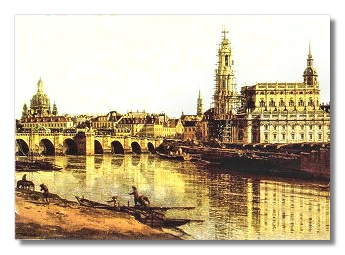
The Internet's Premier Classical Music Source
Related Links
- Augustan Age Articles
-
Introduction
Historical Background
Cultural Display
Music Making at Dresden
The Dresden Hofkapelle
Musicians at Court
Outside Composers
Other Ensembles at Court
Dresden Recordings
Bibliography
Modern Editions
Acknowledgements
Recommended Links
Site News
Music of the Augustan Age
Historical Background
Let me take you back in time to April 1694, to Dresden, the residence of the Electors of Saxony who were descended from the champions of the German Reformation. An event that was to create the most brilliant and extravagant period in its cultural history is about to take place.

When Friedrich Augustus succeeded to the electorate upon the unexpected death of his elder brother Johann Georg IV, the "Augustan Age" had begun. Elector Frederich Augustus I, who had travelled extensively throughout Europe, including Spain and Portugal had acquired in Paris a life long devotion to French poetry and theatre. While in Venice however he was impressed by Italian composers and performers and particularly Italian opera. A hedonist, who reportedly had 354 natural children, he saw in cultural exhibitionism substantial political values and sought to make his court the centre of a great European power. In consequence architecture, painting, sculpture, music and theatre were all actively encouraged.
Until 1697 the electorate of Saxony following the principle "Cuius regnum eius religio" (the state will adopt the prince's religion) laid down at the Peace of Westphalia (1648) had a Protestant ruler and allowed only Lutheranism to be practised in public. However, to serve his political aspirations the Elector Friedrich Augustus I personally converted to Catholicism which enabled his accession to the throne of Poland. As King Augustus II of Poland, more commonly known as Augustus the Strong he had sovereignty over a vast empire. After his personal conversion Augustus and his successors did not attempt to alter the position of Lutheranism as the official state religion of Saxony. This was reinforced in 1706 when due to military reverses at the hands of Sweden he was forced to renounce the throne of Poland. Paradoxically the temporary loss of Poland (which he regained in 1710) made it necessary for the King to prove to the Papal Curia that his conversion was more than skin deep. In 1708, much to the alarm of his Protestant subjects the King transformed the former opera house into a Catholic church that for 12 years led a highly discreet existence.

(The Hofkirche is the building in the process of construction on the right hand side.)
In 1750 his son commissioned the building of the new Catholic court church designed by Chiaveri. Space for internal processions was provided so as not to offend the sensibilities of the local population. The Kings actions were not without consequences as much of the nobility including the Electress Christiane Eberhardine of Brandenburg-Bayreuth refused to embrace the Catholic religion. The Electress insisted that her children be raised as Protestants, separated from her husband and retired to Pretzsch on the Elbe. In 1711, against her wishes the Crown Prince, the future Friedrich Augustus II (King Augustus III of Poland) was sent on the Grand Tour surrounded by a Catholic entourage. Under such pressure the young crown prince quickly buckled and officially converted to Catholicism in 1712. Augustus the Strong fearing unrest in Saxony, kept the news of this conversion a secret until 1717 by which time the Catholic destiny of the ruling house was an irreversible fait accompli.
If you have any comments, additions or questions I would be really pleased to hear from you!
Copyright © 1996-2000, David Charlton.












